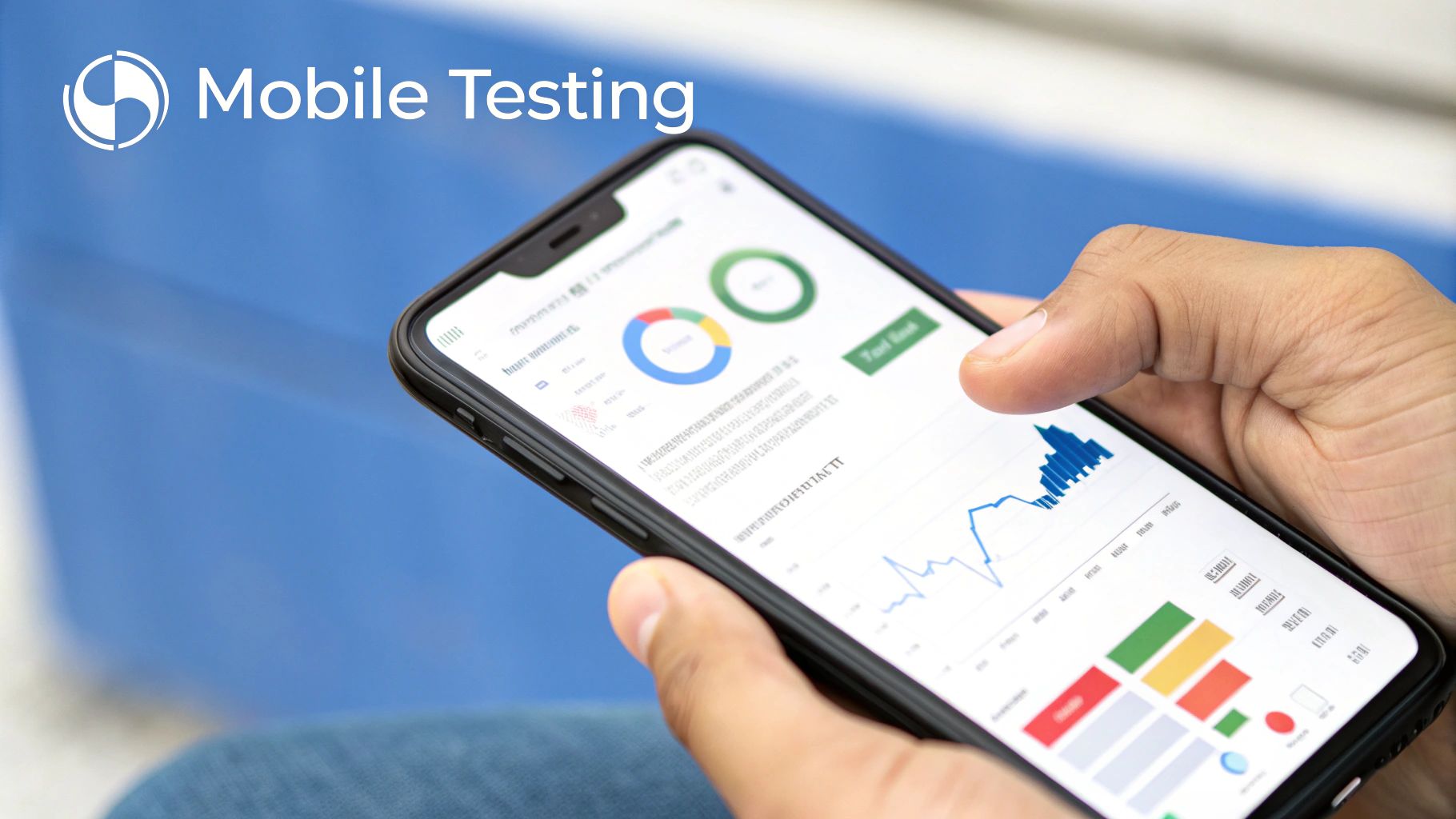Best Software Testing Tools: A Complete Guide for Modern Teams
Navigating Today’s Software Testing Landscape

Software testing has become central to delivering reliable applications that users can depend on. The growing focus on quality has driven substantial market growth, with testing tool investments expected to reach $3.9 billion by 2030, up from $2.3 billion in 2022. This surge reflects how companies are prioritizing robust testing practices to meet rising user expectations. But what’s driving these investments, and how are successful teams adapting their approaches?
The Evolving Challenges of Quality Assurance
Modern applications present unique testing challenges due to their distributed nature. Rather than simple standalone programs, today’s software relies on interconnected microservices, APIs, and cloud systems working together seamlessly. Testing individual code components is no longer enough - teams must verify how these pieces interact and perform under real-world conditions. For instance, an e-commerce app might work perfectly in isolation but fail when payment processing, inventory systems, and user authentication services need to handle concurrent requests.
The widespread adoption of agile and DevOps practices has also changed how teams approach testing. Quick feedback loops and continuous testing are now essential, not optional. Recent studies show that 87% of companies are adopting agile testing tools to help their development and QA teams work more effectively together. This shift requires carefully choosing testing tools that support rapid iteration while maintaining quality standards.
Key Trends Shaping the Future of Testing
Cloud-based testing platforms have gained significant traction, particularly in North America, where they hold 37% market share. These platforms let teams scale their testing infrastructure up or down as needed without heavy upfront costs. AI-powered testing tools are also making an impact by automating repetitive tasks like test case generation and defect prediction, freeing up testers to focus on more nuanced scenarios that require human judgment.
The testing tool market has become increasingly specialized, with solutions targeting specific needs like performance testing, security scanning, and mobile app verification. While having options is good, the sheer number of choices can be daunting. Teams need to evaluate tools based on their specific requirements, technical capabilities, and budget constraints to build an effective testing toolkit.
Embracing the Right Combination of Tools
Most successful testing strategies combine multiple approaches and tools. While automation handles repetitive checks and ensures broad test coverage, manual exploratory testing remains vital for uncovering subtle issues and edge cases that automated tests might miss. Popular tools like Selenium, Cypress, and TestComplete offer powerful features, but their effectiveness depends on how well they fit into a team’s overall testing workflow. The key is building a balanced testing process that leverages both automated and manual testing methods while staying adaptable to new challenges as they emerge.
Mastering Automation Testing Tools

Software teams often struggle with choosing and implementing the right automation tools. While having good tools is important, success comes from understanding how to integrate them effectively into your development process. Let’s explore how to select tools strategically and make them work for your specific needs.
Selecting the Right Automation Testing Tools
With so many testing tools available, making the right choice can feel overwhelming. Focus on these key factors to find tools that match your team’s requirements:
- Programming Language Support: Your testing tools need to work with your tech stack. For example, if you use JavaScript, consider Cypress for end-to-end testing.
- Ease of Use and Maintenance: Look for tools with clear documentation and straightforward setup. The easier the tool is to learn, the faster your team can start using it effectively.
- Integration with Existing Tools: The tool should fit smoothly into your current development pipeline and work well with other testing tools you already use.
- Community Support and Documentation: Active communities and detailed documentation make it much easier to solve problems and learn best practices.
Implementing Automation Testing Best Practices
Once you’ve chosen your tools, follow these proven practices to get the most value from automation:
- Start Small and Scale Gradually: Begin by automating a few important test cases. As your team gains experience, slowly expand your test coverage.
- Prioritize Critical Test Cases: Focus first on automating tests for your core features and areas with the highest risk of bugs.
- Maintain Clear and Concise Test Scripts: Write clean, well-documented test code that’s easy for team members to understand and update.
- Regularly Review and Update Tests: Keep your test suite current by updating tests when features change or new functionality is added.
Measuring the Impact of Automation
Track these key metrics to make sure your automation efforts are paying off:
- Test Coverage: Check what percentage of your code is tested automatically. Many successful teams aim for at least 80% coverage.
- Test Execution Time: Compare how long automated tests take versus manual testing. You should see significant time savings.
- Defect Detection Rate: Monitor how many bugs your automated tests catch. This helps show the value of your testing strategy.
Following these guidelines helps create a more reliable testing process that catches bugs early and speeds up development. For more insights on improving your application’s performance, read our guide on How to master performance testing. By implementing automation thoughtfully, you’ll catch more bugs while spending less time on manual testing.
Implementing Agile Testing Solutions

With 87% of development teams now using agile methods, software testing practices need to keep pace. Gone are the days of testing as a separate phase - modern testing tools must support quick iterations and constant feedback loops. Teams need solutions that work smoothly with agile’s rapid cycles while enabling strong collaboration between developers, testers, and stakeholders.
Choosing the Right Tools for Agile Testing
Finding the right testing tools goes beyond basic features. The tools need to fit naturally into agile workflows and continuous integration pipelines. A tool that requires heavy manual setup for each sprint will only slow teams down. Good agile testing tools make it easy to share results, track progress on shared dashboards, and keep everyone in sync.
When evaluating agile testing tools, look for these key capabilities:
- Integration with CI/CD: Tools should connect smoothly with platforms like Jenkins, GitLab CI, and Azure DevOps to run tests automatically during builds
- Real-Time Reporting and Feedback: Quick access to test results, bug tracking, and testing progress helps teams respond faster
- Collaboration Features: Shared test cases, comment threads, and built-in communication keep everyone on the same page
- Support for Various Testing Types: Tools should handle unit, integration, system, and acceptance testing since agile projects need all of these
Best Practices for Agile Testing Implementation
Getting the tools right is just the start. Effective agile testing requires a mindset shift to build quality throughout development. This means bringing testers into projects from day one so testing shapes design and planning decisions. Testing can’t be an afterthought - it needs to happen continuously during sprints. That’s why automation and fast feedback are so important.
Here are the core practices that make agile testing work:
- Test-Driven Development (TDD): Write the tests first to ensure code meets requirements from the beginning
- Behavior-Driven Development (BDD): Use clear language for acceptance criteria so developers, testers and business users share understanding
- Continuous Integration and Testing: Automated testing as part of CI/CD gives immediate feedback on code changes
When teams pair good tools with these practices, they can deliver quality software at agile speed. Tools like GoReplay help by capturing real user behavior to test against. Recording and replaying actual HTTP traffic lets you confirm applications work reliably under real-world conditions. This practical approach to agile testing helps maintain both speed and quality.
Understanding Cloud-Based Testing Platforms

Testing software effectively requires far more resources than most organizations can maintain in-house. Cloud-based testing platforms have become essential tools for quality assurance teams, particularly in North America where they now represent 37% of the testing market. These platforms provide the infrastructure and tools needed to run comprehensive tests without the overhead of managing physical testing environments. Let’s explore how teams can make the most of cloud testing capabilities.
Benefits Over Traditional Testing Methods
Setting up traditional testing environments demands significant investment in hardware, software licenses, and ongoing maintenance. This creates real barriers, especially for smaller teams with limited budgets. Cloud platforms remove these obstacles by offering instant access to a full range of testing environments - different operating systems, browsers, and mobile devices are available on-demand. For instance, mobile app developers can test their applications across hundreds of device and OS combinations through cloud services, something that would be impractical with physical device labs.
Smart Resource Management and Cost Control
One of the biggest advantages of cloud testing platforms is their flexibility with resources. Teams can quickly add testing capacity when needed, such as before major releases, then scale back during quieter periods. This means you only pay for what you actually use. Consider load testing scenarios - simulating thousands of concurrent users would typically require expensive dedicated hardware that sits idle most of the time. Cloud platforms let you run these intensive tests as needed without the permanent infrastructure costs. Many platforms also include automation features that help teams test more efficiently with less manual work.
Making the Move to Cloud Testing
Successfully adopting cloud-based testing requires clear planning and systematic implementation. Start by mapping out your specific testing requirements - what types of applications need testing, which environments you’ll need to support, and how the platform will work with your current development tools. Pay special attention to security requirements and data handling policies, particularly for sensitive information. When working with distributed teams, cloud platforms can improve collaboration through shared access to testing resources and results. You might be interested in: Harnessing cloud marketplaces for QA and load testing. Success with cloud testing platforms comes from combining the right technical solutions with well-designed processes and strong team coordination.
AI-Powered Testing Solutions
Software testing has evolved significantly with cloud platforms and agile methods enabling faster, more scalable testing processes. As applications become increasingly complex, testing teams are turning to Artificial Intelligence (AI) to enhance their testing capabilities and tackle growing quality assurance challenges.
How AI Enhances Software Testing
AI helps solve several persistent testing bottlenecks that teams face daily. Creating and updating test suites traditionally requires significant time and resources. With AI assistance, teams can automatically generate test cases, spot potential defects through data analysis, and identify risk areas before issues surface. This frees up testers to focus on strategic work like exploratory testing and user experience evaluation. AI analysis also uncovers subtle patterns in test results that manual review might miss.
Key Areas Where AI Makes an Impact
Testing teams are successfully applying AI in several practical ways:
- Better Test Coverage: AI examines code and user interactions to find gaps in test suites and suggests additional test scenarios
- Automated Test Writing: Instead of manual scripting, AI creates tests directly from requirements, user stories, and existing code
- Early Issue Detection: By studying past data and code patterns, AI highlights areas likely to have defects so teams can test strategically
- Simplified Test Updates: AI identifies outdated or duplicate test cases to reduce maintenance work
Consider an online store with thousands of product pages. While manually checking each page would take weeks, an AI tool can quickly scan all pages to find broken links, incorrect product details, or checkout problems.
Implementing AI Testing Tools Effectively
Adding AI testing tools requires thoughtful planning. Here’s what teams should consider:
- Set Clear Goals: Determine specific problems AI should solve - whether that’s expanding test coverage, speeding up test creation, or finding bugs earlier
- Review Tool Features: Compare different AI testing tools based on your needs. Some tools work better for certain types of tests or programming languages
- Begin Small: Start with a pilot project to test AI tools in one area. Learn from the results and adjust your approach based on what works
- Track Results: Monitor key metrics like coverage, execution speed, and bug detection to measure AI’s actual impact
While AI offers exciting possibilities for testing, it’s important to note that the technology continues to develop. Some AI features may need refinement, and teams should be ready to adapt their methods as capabilities grow. The software testing tools market is expected to grow from $2.3 billion in 2022 to $3.9 billion by 2030, showing strong adoption of advanced testing solutions. By understanding both the strengths and current limitations of AI tools, teams can use them effectively alongside human expertise to build stronger testing processes. Success comes from seeing AI as a powerful assistant that makes testers more effective, rather than a replacement for human judgment in ensuring software quality.
Building Your Optimal Testing Toolkit
A well-designed testing toolkit brings together essential tools to create a strong quality assurance process. Like assembling a team of specialists, your testing toolkit should include components that work together seamlessly while each serving a specific purpose. Let’s explore how to build a testing toolkit that meets your unique development needs.
Defining Your Testing Requirements
Start by clearly outlining what your testing needs to accomplish. Consider the type of software you’re developing - whether it’s web applications, mobile apps, or embedded systems. Each requires different testing approaches. For instance, if you’re building financial software, security testing should be a top priority. Meanwhile, gaming applications need rigorous performance and user experience testing. Also consider practical factors like team size and technical expertise. Small teams often work best with intuitive tools requiring minimal setup, while larger teams can handle more sophisticated solutions. This initial assessment helps ensure you select tools that truly fit your requirements.
Selecting Tools for a Balanced Approach
Much like maintaining a balanced diet, effective testing requires the right mix of tools and methods. Combine automated testing for repetitive tasks like regression checks with thoughtful manual testing to catch subtle usability issues. Think of automated tests as providing the solid foundation - handling core functionality checks efficiently. Manual testing then adds crucial finishing touches, uncovering edge cases and user experience issues that automation might miss. Finding the right balance between these approaches helps maximize test coverage while making the best use of your resources.
Integrating Your Testing Tools
Your testing tools should function as one cohesive system rather than separate pieces. Focus on selecting tools that integrate smoothly with each other and fit naturally into your development workflow. For example, your test automation framework needs to connect easily with your Jenkins or other CI/CD pipeline to run tests automatically during builds. When all components work together smoothly, you create an efficient and reliable testing process.
Evaluating and Refining Your Toolkit
Building an effective testing toolkit requires ongoing evaluation and improvement. Regularly assess whether your tools are helping catch bugs early, enabling efficient testing, and providing useful insights. Be ready to replace underperforming tools or add new ones as your needs evolve. With the testing tools market expected to grow from $2.3 billion in 2022 to $3.9 billion by 2030, new solutions emerge regularly. Stay informed about new testing approaches and tools that could enhance your process.
Ready to strengthen your testing toolkit? GoReplay, an open-source tool, captures and replays live HTTP traffic to create tests based on real user interactions. This helps uncover issues that might only appear under actual usage conditions. See how GoReplay can improve your testing process: https://goreplay.org
